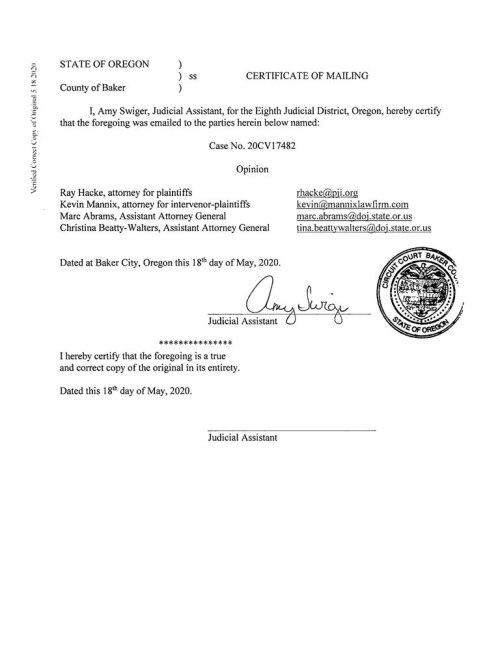Oregon Supreme Court: Shutdown orders stand despite Baker County ruling
Published 4:15 pm Monday, May 18, 2020

- DocumentFragment_85898905-7.jpg
The Oregon Supreme Court ruled late Monday that Gov. Kate Brown’s executive orders regarding the coronavirus pandemic will stand statewide until the court hears arguments in the case following a Baker County judge’s ruling earlier Monday that the orders were “null and void.”
“Following swift action by the Oregon Supreme Court, my emergency orders to protect the health and safety of Oregonians will remain in effect statewide while the court hears arguments in this lawsuit,” Brown said in a statement Monday night about the court’s emergency ruling.
Trending
Baker County Circuit Court Judge Matthew B. Shirtcliff had earlier in the day ruled Brown had exceeded her authority by restricting activities, including church services and businesses, for longer than the 28 days the governor is authorized under a state law.
The judge granted a preliminary injunction blocking enforcement of the more than 10 executive orders the governor has issued since March 8.
Shirtcliff’s decision would apply to the entire state. He ruled on the motions because the lawsuit challenging the duration of the governor’s legal authority was filed May 6 in Baker County Circuit Court.
Elkhorn Baptist Church of Baker City is the lead plaintiff in the lawsuit, which was filed by Salem attorney Ray Hacke of the Pacific Justice Institute, a nonprofit that defends religious liberty.
Bill Harvey, chairman of the Baker County Board of Commissioners, filed as an intervenor-plaintiff in the case as an individual rather than in his capacity as an elected official.
Harvey and Commissioner Bruce Nichols, who is not involved in the lawsuit, both attended a 20-minute hearing Monday morning at the Baker County Courthouse during which Shirtcliff announced his decision.
Trending
Harvey said after the hearing that the injunction “is what we were seeking.”
“Our emphasis was that she (Brown) overstepped her bounds,” Harvey said.
Grant County Commissioner Sam Palmer and Grant County Sheriff Glenn Palmer also signed on as intervenors in the case with eight others from Baker, Deschutes, Josephine and Wallowa counties.
In an affidavit, Sheriff Palmer said the shutdown orders have caused an 80% reduction in sheriff’s office revenue and required changes at the jail.
“The executive orders of the governor have severely affected businesses in my county, which are unable to operate because they have been ordered closed or placed under considerable restriction” despite only one positive case of COVID-19 in the county, Sheriff Palmer said in the affidavit.
Sam Palmer told the Eagle his faith is what led him to sign on to the lawsuit. He said he did not go out of his way to use politics and signed on as an individual, rather than an elected official.
In an affidavit, he said Grant County has had one of the worst unemployment rates in the state for 30 to 40 years and the shutdown orders have had an extraordinary impact that may cause businesses to close.
“Restrictions on church services are also devastating in that, in light of the effects of the governor’s executive orders, we need our churches more than ever so that people may gather together and pray,” he said in the affidavit.
Sam Palmer told the Eagle he received an email from state Sen. Brian Boquist surprised that the governor’s office bypassed the Court of Appeals and went straight straight to the Oregon Supreme Court.
“I don’t know if that’s good, bad or indifferent,” he said.
Sam Palmer said he expects the Oregon Supreme Court will rule on the lawsuit by the end of the week.
“I think the laws are pretty black and white, so I feel confident that, if they follow the laws, the places of faith can open back up,” he said.
Two attorneys from the Oregon Department of Justice who are representing Brown asked Shirtcliff to either issue a stay, meaning the preliminary injunction wouldn’t take effect immediately, or to wait 48 hours before entering his decision into the record, which would have the same effect.
Shirtcliff denied both requests, saying he would enter his decision immediately.
The governor’s lawyers, Marc Abrams and Christina Beatty-Walters, sought an immediate review of Shirtcliff’s decision by the Oregon Supreme Court, with a goal of overturning his ruling.
Solicitor General Benjamin Gutman filed a petition with the state’s highest court Monday afternoon.
Abrams said there is evidence that measures in the governor’s executive orders have been effective at curbing the spread of the coronavirus, and that Shirtcliff should delay the injunction as a result.
But Hacke countered that the “issue is not whether it’s working. It’s whether she has exceeded the limits of her authority.”
Since Shirtcliff has agreed that Brown has exceeded that authority, Hacke argued, delaying the injunction would in effect render the injunction moot.
In his written decision, the judge compared grocery stores and other businesses that have remained open, without social distancing guidelines, to churches, writing that churches can use the same precautions during worship services that involve more than 25 people, which has been the limit under the governor’s executive orders.
In separate statements, both Brown — who appointed Shirtcliff to replace retiring Judge Greg Baxter last fall — and Oregon Attorney General Ellen Rosenblum took issue with Shirtcliff’s decision.
“Today’s ruling from the Baker County Circuit Court will be appealed to the Oregon Supreme Court within hours to keep my emergency orders in effect,” Brown said in a press release. “This will ensure we can continue to safeguard the health of all Oregonians — including frontline health care workers, those living in nursing homes, workers in agriculture and food processing plants, and Oregonians with underlying health conditions — while the legal process moves forward.”
Rosenblum said: “We will argue that the judge erred in his construction of the relevant statutes and that he abused his discretion in issuing the preliminary injunction.”
In granting the plaintiffs’ motion for a preliminary injunction, Shirtcliff concluded that Brown, by citing a certain state law in some of her executive orders since her original emergency declaration March 8, in effect placed a 28-day limit on the state’s enforcement of those orders.
That law is Oregon Revised Statute 433.441.
The law gives the governor a variety of powers, including the authority to “control or limit entry into, exit from, movement within and the occupancy of premises in any public area …”
Although Brown invoked a different law — ORS 401.165 — when she initially declared an emergency, Shirtcliff wrote that 401.165 “does not grant the Governor power directly over the movement of citizens and gatherings.”
ORS 401.165 also does not include any time limits on the duration of the emergency. Brown has subsequently extended the emergency declaration through July 6.
That declaration is separate from the multiple executive orders the governor has issued. Brown eased some restrictions included in those executive orders on May 15 when she authorized most of the state’s 36 counties, including Grant, to move into the first phase of the state’s reopening plan.
The crux of the legal dispute involves the relationship between the two laws the governor has invoked — 401.165 and 433.441.
Brown’s attorneys argued in a May 14 hearing that because the governor cited 401.165 in the emergency declaration, that law, which has no time limits, is the controlling statute.
But Hacke argued — and Shirtcliff agreed — that the governor, by repeatedly citing ORS 433.441 in her executive orders, made those orders subject to the 28-day time limit allowed under that law for public health emergencies.
Moreover, Shirtcliff wrote in his decision that Brown, in order to issue executive orders that restrict residents’ movements and the size of their gatherings, had to involve 433.441 because 401.165 doesn’t give her that authority.
In his decision, Shirtcliff specifically mentioned Brown’s first executive order.
“This court finds that when the Governor utilized the provisions of ORS 433.441 in her executive order, she triggered all the provisions of ORS 433.441 including the time restrictions,” the judge wrote. “By doing so, the executive order became null and void beyond the maximum 28-day time period allowed by the statute. Moreover, by not complying with (the) timelines, the Governor’s subsequent Executive Orders 20-05 through 20-25 are also null and void.”
In addressing the potential conflict between the two laws — one with no time limit and one with a 28-day limit — Shirtcliff wrote that “the statutes are to be read to work together with the more specific statute governing.”
The judge cited a 1956 Oregon case, Colby v. Larson.
Shirtcliff concluded that ORS 433.411 — the public health emergency law with the 28-day limit — prevails because it is more specific in that it deals with a particular type of emergency (public health), because it gives the governor specific authority, in this case the ability to control citizens’ movements and gatherings, and because it includes a time limit.
In their lawsuit the plaintiffs also cited an amendment to the Oregon Constitution — Article X-A — that Oregon voters added in a ballot measure in November 2012.
That section allows the governor to declare a “catastrophic disaster,” including in the event of a pandemic, and it sets a 30-day limit on the declaration unless the Legislature agrees to extend it.
Shirtcliff agreed with the governor’s lawyers that Article X-A doesn’t apply in this case because Brown has not cited that article in her emergency declaration or subsequent executive orders.
Shirtcliff addressed the four-part test that courts consider in deciding whether to grant a preliminary injunction — whether the plaintiffs are likely to prevail in a trial — the judge obviously believes they would prevail since he found the plaintiffs’ case persuasive; whether the plaintiffs are likely to suffer irreparable harm if they don’t prevail; balancing the effects on the plaintiffs and on the defendant; and whether the injunction is in the public interest.
The judge concluded that granting the injunction furthers the public interest “by allowing people to fully exercise their right to worship and conduct their business.”
In balancing the effects of granting the injunction, Shirtcliff conceded that the pandemic is “an unprecedented crisis in our state as well as in this country.”
The judge also acknowledged that Brown “has an enormous responsibility to protect the lives of the citizens of our state balanced against the citizens’ constitutional rights to freedom of religion.”
But Shirtcliff concluded that continuing the current executive orders is “not required for public safety when Plaintiffs can continue to utilize social distancing and safety protocols at larger gatherings involving spiritual worship, just as grocery stores and businesses deemed essential by the Governor have been authorized to do.”
As for the concept of irreparable harm, Shirtcliff ruled that the plaintiffs have made a “sufficient showing” of such harm based on infringement both on their freedom to worship as they see fit, and on their loss of business opportunities due to the governor’s executive orders.
In the petition filed with the Oregon Supreme Court, Gutman wrote that Shirtcliff committed a “fundamental legal error” in granting the preliminary injunction.
Specifically, Gutman contends that the basis of Shirtcliff’s decision was legally flawed — the judge’s conclusion that the governor’s authority under ORS 401.165 is limited to 28 days due to provisions in ORS 433.441.
Gutman argues that provisions in the latter law — the one with the 28-day limit — “supplement rather than supplant” the governor’s authority under the former law.
Further, Gutman contends, because Brown didn’t declare a state of emergency under ORS 433.411, her authority is not limited by the time limits in that statute.
Gutman argues that the two statutes are designed to deal with much different situations — ORS chapter 433 dealing with public health emergencies while ORS chapter 401 — the one Brown invoked, and that has no time limits — is for “much larger-scale emergencies” such as the pandemic.
Gutman contends to barring enforcement of the executive orders “creates a renewed public-health crisis.”









